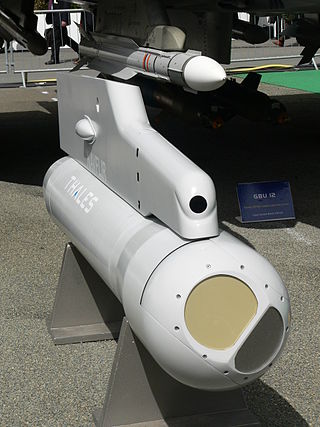
Forward-looking infrared (FLIR) cameras, typically used on military and civilian aircraft, use a thermographic camera that senses infrared radiation.

Lego Mindstorms is a discontinued hardware and software structure which develops programmable robots based on Lego building blocks. Each version includes an intelligent brick, a set of modular sensors and motors, and parts from the Lego Technic line to create the mechanical systems. The system is controlled by the intelligent brick, which act as the brain of the mechanical system.
leJOS is a firmware replacement for Lego Mindstorms programmable bricks. Different variants of the software support the original Robotics Invention System, the NXT, and the EV3. It includes a Java virtual machine, which allows Lego Mindstorms robots to be programmed in the Java programming language. It also includes 'iCommand.jar' which allows you to communicate via bluetooth with the original firmware of the Mindstorm. It is often used for teaching Java to first-year computer science students. The leJOS-based robot Jitter flew around on the International Space Station in December 2001.

Roomba is a series of autonomous robotic vacuum cleaners made by the company iRobot. Introduced in September 2002, they have a set of sensors that enable them to navigate the floor area of a home. These sensors can detect the presence of obstacles, particularly dirty spots on the floor, and steep drops.

The BASIC Stamp is a microcontroller with a small, specialized BASIC interpreter (PBASIC) built into ROM. It is made by Parallax, Inc. and has been popular with electronics hobbyists since the early 1990s.

iRobot Corporation is an American technology company that designs and builds consumer robots. It was founded in 1990 by three members of MIT's Artificial Intelligence Lab, who designed robots for space exploration and military defense. The company's products include a range of autonomous home vacuum cleaners (Roomba), floor moppers (Braava), and other autonomous cleaning devices.
Parallax Inc. is a privately held company in Rocklin, California. Parallax Inc. designs, manufactures, and sells BASIC Stamp microcontrollers, Propeller microcontrollers, microcontroller accessories, educational robot kits, and educational curriculum.
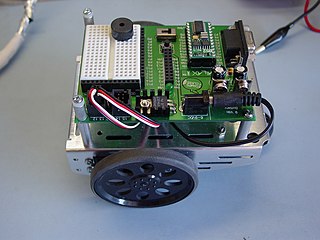
BOE–Bot is short for Board of Education robot. It is the trade name of a robot kit that is used in junior high, high school and college robotics classes. It consists of a main circuit board and breadboard, a plug–in BASIC Stamp microcontroller, two servo motors to drive the wheels, and an aluminum chassis that the parts bolt onto. Students can use Erector set parts, Lego blocks, and additional servos to build custom projects. The BOE-bot has been manufactured and sold by Parallax Inc since 1998.
HERO is a series of several educational robots sold by Heathkit during the 1980s. The Heath Company began the HERO 1 project in October 1979, with the first release in 1982. Models include the HERO 1, HERO Jr., and HERO 2000. Heathkit supported the HERO robot line until 1995. All three were produced as kits, or for more money, prebuilt by Heathkit. The 1980s models are considered collectors items, due to their rarity. For the most part, they cannot perform practical tasks, but are more geared toward entertainment and education above all.

The Parallax P8X32A Propeller is a multi-core processor parallel computer architecture microcontroller chip with eight 32-bit reduced instruction set computer (RISC) central processing unit (CPU) cores. Introduced in 2006, it is designed and sold by Parallax, Inc.
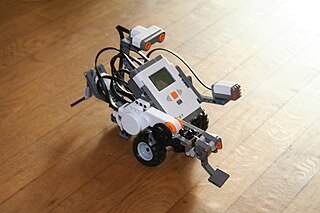
Lego Mindstorms NXT is a programmable robotics kit released by Lego on August 2, 2006. It replaced the first-generation Lego Mindstorms kit, which was called the Robotics Invention System. The base kit ships in two versions: the Retail Version and the Education Base Set. It comes with the NXT-G programming software, or optionally LabVIEW for Lego Mindstorms. A variety of unofficial languages exist, such as NXC, NBC, leJOS NXJ, and RobotC. The second generation of the set, the Lego Mindstorms NXT 2.0, was released on August 1, 2009, featuring a color sensor and other upgraded capabilities. The third generation, the EV3, was released in September 2013.

Institute for Personal Robots in Education (IPRE) was initiated by a $1 million grant from Microsoft Research to Bryn Mawr College and the Georgia Institute of Technology and announced in July 2006. IPRE is designing introductory computer science curricula centered on a Personal Robot. Their vision is that each student will purchase a small, inexpensive robot at the bookstore which they will use throughout their classes in exploring computer science. The hope is that the robot will cost about as much as a textbook. IPRE will develop the hardware, software, and curricular materials for these courses.

iRobot Create is a hobbyist robot manufactured by iRobot that was introduced in 2007 and based on their Roomba vacuum cleaning platform. The iRobot Create is explicitly designed for robotics development and improves the experience beyond simply hacking the Roomba. The Create replaces its Roomba predecessor's vacuum cleaner hardware with a cargo bay that also houses a DB-9 port providing serial communication, digital input & output, analog input & output, and an electric power supply. The Create also has a 7-pin Mini-DIN serial port through which sensor data can be read and motor commands can be issued using the iRobot Roomba Open Interface (ROI) protocol.
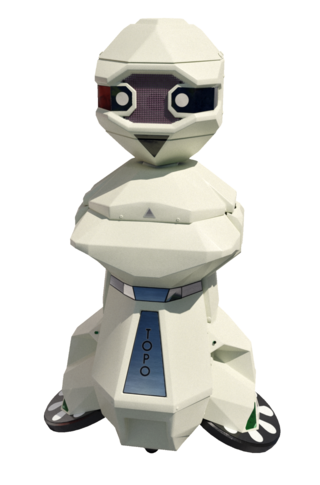
Topo is a series of robots designed in the 1980s by Androbot Inc., for the consumer and education markets. It is wirelessly programmable via an Apple II with a modified version of Apple BASIC called TopoBASIC. The program allows the robot to perform a set of geometric movements, to move about a room and perform tasks. It is like a servant robot, although it does not truly meet the requirements of a robot, as it had no sensors to use to receive input and then make decisions accordingly. It also cannot communicate back with the Apple II any information, nor calibrate its own motors to ensure an accurate task is being performed

HEXBUG is a brand of infrared and automaton toys developed and distributed by Innovation First International. HEXBUG uses many elements used in BEAM robotics. First piloted in the US through RadioShack, HEXBUG is now sold in most major retail stores. The original Hexbugs are based on six-legged arthropods but now come in several different varieties. The name "HEXBUG" relates to the six-sided packaging it is sold in, rather than to its number of legs.

Botball is an educational robotics program that focuses on engaging middle and high school aged students in team-oriented robotics competitions. Thousands of children and young adults participate in the Botball program. It has been active since 1998 and features a robotics curriculum which focuses on designing, building and programming a pair of autonomous robots. Teams use a standardized kit of materials, document the process and then compete in a tournament in which the challenges change annually. All materials in the kits are exactly the same for every team around the world, so there are no unfair advantages. Botball teams are mostly based in the United States with over 300 teams and local tournaments in more than a dozen regions. In recent years it also holds an annual Global Conference on Educational Robotics (GCER), with an international tournament that attracts teams all over the country as well as from Mexico, Austria, China, Uganda, Poland, Qatar, Kuwait, Egypt, and many others.
Kionix, Inc. is a manufacturer of MEMS inertial sensors. Headquartered in Ithaca, New York, United States, the company is a wholly owned subsidiary of ROHM Co., Ltd. of Japan. Kionix developed high-aspect-ratio silicon micromachining based on research originally conducted at Cornell University. The company offers inertial sensors, and development tools and application support to enable motion-based gaming; user-interface functionality in mobile handsets, personal navigation and TV remote controllers; and hard-disk-drive drop protection in mobile products. The company's MEMS products are also used in the automotive, industrial and health-care sectors. Kionix is ISO 9001:2008 and TS16949 registered.
Dexter Industries is a company that designs robots for education, research, and personal use. The company makes several products that expand the LEGO Mindstorms, Raspberry Pi, and Arduino prototype system.
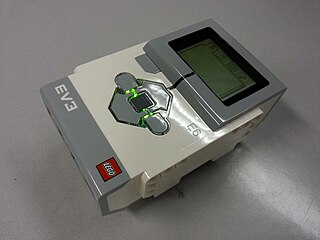
LEGO Mindstorms EV3 is the third generation robotics kit in LEGO's Mindstorms line. It is the successor to the second generation LEGO Mindstorms NXT kit. The "EV" designation refers to the "evolution" of the Mindstorms product line. "3" refers to the fact that it is the third generation of computer modules - first was the RCX and the second is the NXT. It was officially announced on January 4, 2013, and was released in stores on September 1, 2013. The education edition was released on August 1, 2013. There are many competitions using this set, including the FIRST LEGO League Challenge and the World Robot Olympiad, sponsored by LEGO.
Sphero, Inc. is an American consumer robotics and toy company based in Boulder, Colorado.














